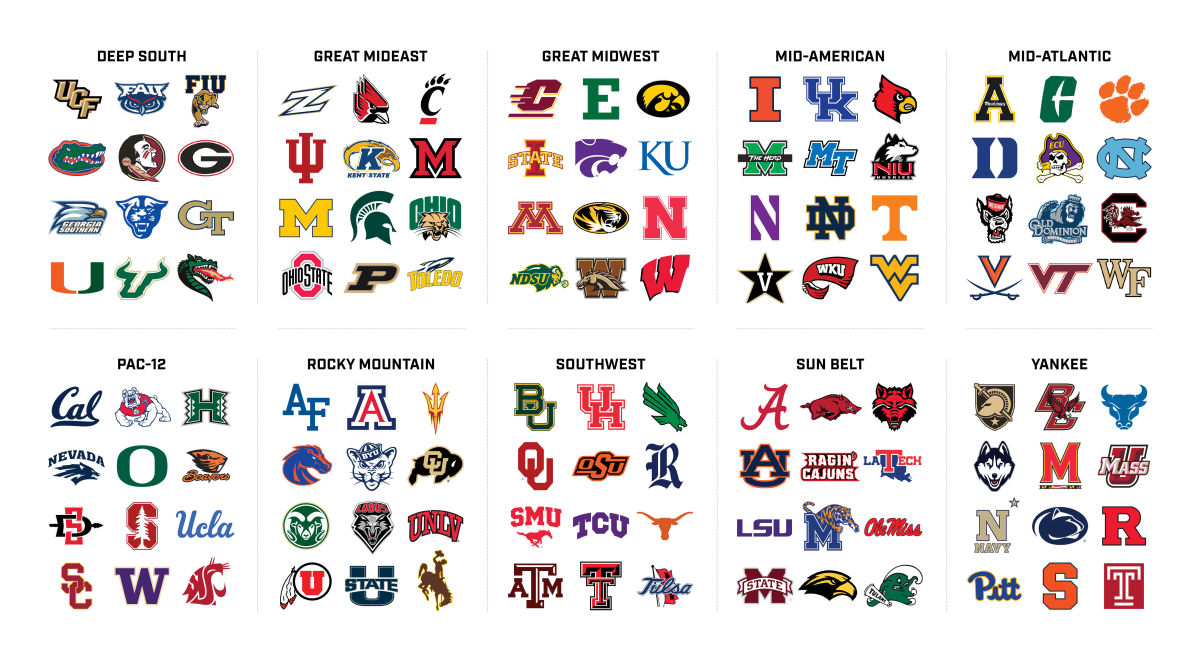A Look at BYU's New Home in Pat Forde's Realignment Proposal

Sports Illustrated's Pat Forde took on the task of realigning the college football landscape. You can read the full story here. Forde's reasoning for realignment is simple - the current landscape doesn't make sense geographically. It also doesn't support a competitive landscape for every school. This is a cause that BYU fans could get behind. Let's take a look at BYU's new home in Pat Forde's realignment proposal.
First things first, here are the highlights of his realignment proposal:
- "A 120-school ecosystem, with 11 current FBS members relegated to FCS and one elevated from that level. Congratulations to North Dakota State; condolences to UTEP, Texas State, UTSA, South Alabama, Louisiana-Monroe, Bowling Green, New Mexico State, San Jose State, Coastal Carolina, Troy and Liberty. (Relegation/elevation can be revisited every three seasons.)
- Ten leagues, each with 12 members, each designed to maximize proximity and reduce travel demands and costs. All current conference structures are broken and reassembled. There are no more than eight Power 5 programs in a single new conference, and no fewer than four. And there are no independents—yes, Notre Dame is in a conference.
- In football, each school will play a full round-robin schedule plus one nonconference game (no FCS opponents). The nonconference opponent will be locked in for a minimum of four seasons before there is an opt-out to schedule someone different. There will be no conference championship games.
- All 10 conference champions, plus two at-large teams chosen by a selection committee, advance to the expanded College Football Playoff. The teams are seeded by the committee. The top four receive a first-round bye, while seeds 5–8 host seeds 9–12 at their home stadiums the first weekend of December. Quarterfinals are played the next week at the home stadiums of seeds 1–4. The semifinals and championship game are conducted under the current CFP format.
- There still will be bowl games for the teams that don’t make the CFP. Just fewer of them, which nobody should mind.
- The conferences will work for basketball and other sports as well—in fact, it will be better for nonrevenue sports in terms of travel cost savings. The 230-odd non-FBS programs that are part of NCAA Division I will remain aligned pretty much where they already are, with a few exceptions." - Pat Forde, Sports Illustrated
Here is how the 10 conferences would look:

In Forde's proposal, BYU would be in a 12-team conference with the following schools:
- Air Force
- Arizona
- Arizona State
- Boise State
- BYU
- Colorado
- Colorado State
- New Mexico
- UNLV
- Utah
- Utah State
- Wyoming
From a rivalry perspective, this is the best-case scenario for BYU. The Cougars would play their three rivalry games on an annual basis - Utah, Utah State, and Boise State. BYU would also be able to resurrect old relationships with schools like Colorado Sate, Wyoming, UNLV, and New Mexico. BYU and Arizona have played some great games over the last 15 years, that's a matchup that could become a rivalry over time.
This scenario would be very intriguing from a college football playoff perspective. In Forde's plan, the conference champion would earn an automatic bid to the college football playoff. This proposed conference would be difficult, but not impossible, for BYU to win. They wouldn't have to compete against a powerhouse like USC or Oregon on an annual basis.
In addition, this conference would boost BYU's recruiting profile. In the current landscape, the P5 label is king. A leveled playing field would help BYU on the recruiting trail.
In this scenario, who would you miss playing the most?
What would be the biggest downside?
Would you miss independence?
Want to share opinions or ask questions? We want to hear them! Making a profile is free and it only takes ~1 minute to set up. Also, be sure to like us on social media for future coverage:
Facebook - @BYUSportsIllustrated
Twitter - @SI_BYU and Casey Lundquist at @casey_lundquist
Instagram - @BYU_SI
